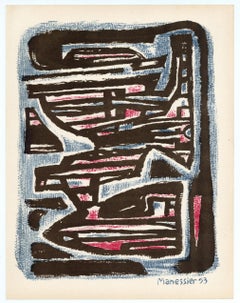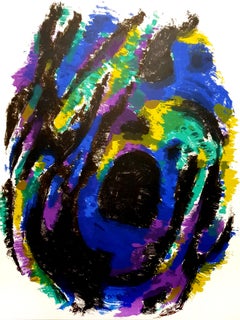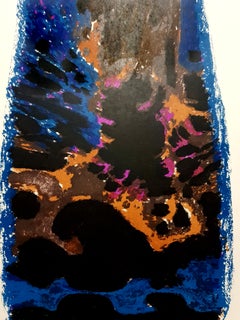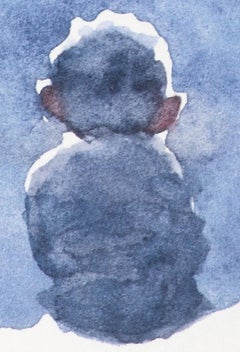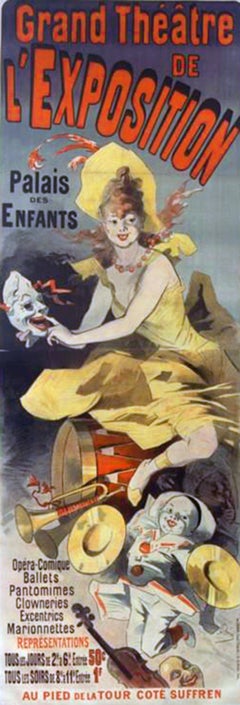Alfred MANESSIER Figurative Prints
French, 1911-1993
Alfred Manessier was born on 5 December 1911 in Saint-Ouen in the Somme. Trained at the Ecole des Beaux-Arts in Amiens (1924 - 1929), he completed his training at the Ecole des Beaux-Arts in Paris and spent a brief period in the studio of the painter Roger Bissière, who introduced him to frescoes and to whom he took refuge in Boissiérettes in the Lot at the beginning of the war.
From 1947 onwards, stained glass occupied a large part of his work, which was now based on abstraction. He carried out about twenty projects in France, including the stained glass windows for the church of Saint-Michel des Bréseux (Doubs), his first commission (1948 - 1950), those in the church of Saint-Pierre de Trinquetaille in Arles (1953), and the chapel of Sainte-Thérèse de l'Enfant Jésus et de la Sainte Face in Hem (Nord - 1957). The stained glass windows of the Church of the Holy Sepulchre in Abbeville, one of his last commissions carried out between 1982 and 1993, are considered his masterpiece. He also executed a dozen stained glass projects in Switzerland, Germany and Spain.
As an abstract painter of the Ecole de Paris, Manessier frequently tackled subjects related to the Catholic religion. His paintings are often inspired by the landscapes of Northern France, but also by his travels. From 1956 onwards, he produced a large number of political paintings entitled "Hommage", which echoed the violence in the world.
The dissemination of his artworks in the public space through these stained glass windows gave him great notoriety during his lifetime, and his paintings were awarded numerous international prizes (such as the Grand Prix of the Venice Biennale, which he received in 1962, alongside Albert Giacometti, who received the Grand Prix for sculpture).
He died on 1er August 1993 as a result of a car accident, shortly after the completion of the stained glass windows in Abbeville.to
3
Overall Width
to
Overall Height
to
2
28
847
382
381
308
3
1
2
3
2
2
2
1
1
1
1
3
2
1
Artist: Alfred MANESSIER
original lithograph
By Alfred Manessier
Located in Henderson, NV
Medium: original lithograph. Impression on wove paper, executed for the hard-to-find XXe Siecle (No. 4), published in Paris in 1954 by San Lazzaro. Sheet size 12 3/8 x 9 5/8 inches (...
Category
1950s Alfred MANESSIER Figurative Prints
Materials
Lithograph
Alfred Manessier - Original Lithograph
By Alfred Manessier
Located in Collonge Bellerive, Geneve, CH
Alfred Manessier - Original Lithograph
Colorful Abstraction
1962
From XXe Siecle
Dimensions: 32 x 24
Edition: G. di San Lazzaro.
Unsigned and unumbered as issued
Category
1960s Modern Alfred MANESSIER Figurative Prints
Materials
Lithograph
Alfred Manessier - Lithograph
By Alfred Manessier
Located in Collonge Bellerive, Geneve, CH
Alfred Manessier - Lithograph
1962
From the art periodical XXe Siecle (no. 20)
Dimensions: 32 x 24
Edition: G. di San Lazzaro.
Unsigned and unnumbered as issued
Category
1960s Modern Alfred MANESSIER Figurative Prints
Materials
Lithograph
Related Items
Starry Night - Limited Edition, Figurative, Contemporary, Star, Night, Child
By Charlie Mackesy
Located in Knowle Lane, Cranleigh
Starry Night is a lithograph based on a watercolour by Charlie Mackesy. The edition is limited to 150 and each piece has been signed by Charlie Mackesy...
Category
2010s Other Art Style Alfred MANESSIER Figurative Prints
Materials
Lithograph
$3,344
H 11.82 in W 7.88 in D 0.4 in
Grand Theatre de l’Exposition, from Les Maîtres de l'Affiche
By (after) Jules Cheret
Located in New York, NY
This lithograph in colors with raised chop mark was printed by Imprimerie Chaix in Les Maîtres de l'Affiche, 1899, on fine woven, heavy stock paper. Measures 15 ¾ x 11 3/8 (40 x 29 c...
Category
19th Century Modern Alfred MANESSIER Figurative Prints
Materials
Lithograph
$695
H 15.75 in W 11.38 in
"Lion Tamer" framed signed lithograph by Alexander Calder. Edition EA of 100.
By Alexander Calder
Located in Boca Raton, FL
"Lion Tamer" lithograph by Alexander Calder. Hand-lettered EA in lower left front corner. Hand-signed Calder in lower right front corner. From an ed...
Category
1970s Modern Alfred MANESSIER Figurative Prints
Materials
Lithograph
$12,000
H 31 in W 39.25 in
Hand of Africa - Mandela, Former South African President, Signed Artwork, Hand
By Nelson Mandela
Located in Knowle Lane, Cranleigh
Nelson Mandela, Hand of Africa, Signed Limited Edition Lithograph
Many people are unaware that Nelson Mandela turned his hand to art in his 80's as a way of leaving a legacy for his ...
Category
Early 2000s Contemporary Alfred MANESSIER Figurative Prints
Materials
Lithograph
$20,069
H 25.5 in W 20 in D 2 in
TAKASHI MURAKAMI DOB & Me On the Red... Hand signed & numbered Superflat Pop Art
By Takashi Murakami
Located in Madrid, Madrid
DOB & Me: On the Red Mound of the Dead
Date of creation: 2013
Medium: Offset lithograph with silver on paper
Edition: 300
Size: 50 x 50 cm
Condition: In mint conditions and not frame...
Category
2010s Pop Art Alfred MANESSIER Figurative Prints
Materials
Varnish, Lithograph, Offset
$2,935
H 19.69 in W 19.69 in
René Magritte - LE DOMAINE D'ARNHEIM Limited Surrealism French Contemporary
By (after) René Magritte
Located in Madrid, Madrid
René Magritte - LE DOMAINE D'ARNHEIM, 1962 (THE DOMAIN OF ARNHEIM)
Date of creation: 2010
Medium: Lithograph on BFK Rives Paper
Edition number: 155/275
Size: 60 x 45 cm
Condition: Ne...
Category
Mid-20th Century Surrealist Alfred MANESSIER Figurative Prints
Materials
Paper, Lithograph
$1,170
H 23.63 in W 17.72 in
RENÉ MAGRITTE LA GRANDE FAMILLE, 1963 Limited edition Lithograph - Surrealism
By (after) René Magritte
Located in Madrid, Madrid
LA GRANDE FAMILLE, 1963 (THE LARGE FAMILY)
Date of creation: 2010
Medium: Lithograph on BFK Rives Paper
Edition: 275
Size: 60 x 45 cm
Observations: Lithograph on BFK Rives paper plat...
Category
Mid-20th Century Surrealist Alfred MANESSIER Figurative Prints
Materials
Lithograph
$1,170
H 23.63 in W 17.72 in D 0.08 in
RENÉ MAGRITTE L'EMPIRE DES LUMIÈRES, 1964 Limited edition Lithograph, Surrealism
By (after) René Magritte
Located in Madrid, Madrid
L'EMPIRE DES LUMIÈRES, 1964 (THE EMPIRE OF LIGHTS, 1964)
Date of creation: 2010
Medium: Lithograph on BFK Rives Paper
Edition: 275
Size: 60 x 45 cm
Observations: Lithograph on BFK Ri...
Category
Mid-20th Century Surrealist Alfred MANESSIER Figurative Prints
Materials
Lithograph
$1,170
H 23.63 in W 17.72 in D 0.08 in
TAKASHI MURAKAMI: There are little people inside. me Superflat, Japanese Pop Art
By Takashi Murakami
Located in Madrid, Madrid
THERE ARE LITTLE PEOPLE INSIDE ME
Date of creation: 2011
Medium: Offset print with silver and silkscreen with spot UV varnishing
Edition: 300
Size: 66.5 x 56.4 cm
Observations: Offse...
Category
2010s Pop Art Alfred MANESSIER Figurative Prints
Materials
Varnish, Lithograph, Offset
$3,236
H 26.19 in W 22.21 in
Original 1919, Give the World The Once Over in the United States Navy poster
Located in Spokane, WA
Original 1919 Give The World The Once Over in the United States Navy vintage poster. Archival linen backed. This poster presents itself very fine condition. The lower text por...
Category
1910s American Modern Alfred MANESSIER Figurative Prints
Materials
Lithograph
$2,998
H 42 in W 28.5 in D 0.05 in
Alexander Calder Circus Reproduction Lithograph After a Drawing
By (after) Alexander Calder
Located in Surfside, FL
(after) Alexander Calder
"Calder's Circus" offset lithograph on wove paper after drawings by the artist
Published by Art in America and Perls gallery in 1964 (from drawings done in the 1930's)
these range slightly in size but they are all about 13 X 17 inches (with minor variations in size as issued.) These have never been framed. The outer folio is not included just the one lithograph.
James Sweeny from the introduction “The fame of Calder’s circus spread quickly between the years 1927 and 1930. All the Paris art world came to know it. It brought him his first great personal success. But what was more important, the circus also provided the first steps in Calder’s development as an original sculptor”
Clive Gray wrote ”A visit to the studio of Alexander Calder led to the chance discovery of some hundred masterful circus drawings completed over thirty years ago. We publish, for the first time, a choice of sixteen from that group.” With signed introduction by Miro.
These whimsical drawings, done in the style of wire sculpture, include acrobats, clowns, jugglers, trapeeze artists, an elephant, dog and lion. they are great.
Alexander Calder is widely considered to be one of the most important American sculptors of the 20th century. He is best known for his colorful, whimsical abstract public sculptures and his innovative mobiles, kinetic sculptures powered by motors or air currents, which embraced chance in their aesthetic. Born into a family of accomplished artists, Calder's work first gained attention in Paris in the 1930s and was soon championed by the Museum of Modern Art in New York, resulting in a retrospective exhibition in 1943. Major retrospectives were also held at the Solomon R. Guggenheim Museum (1964) and the Museum of Contemporary Art, Chicago (1974). Calder’s work is in many permanent collections, most notably in the Whitney Museum of American Art, but also the Guggenheim Museum; the Museum of Modern Art; the National Gallery of Art, Washington, D.C.; and the Centre Georges Pompidou. He produced many large public works, including .125 (at JFK Airport, 1957), Pittsburgh (Carnegie International prize winner 1958, Pittsburgh International Airport) Spirale (UNESCO in Paris, 1958), Flamingo and Universe (both in Chicago, 1974), and Mountains and Clouds (Hart Senate Office Building, Washington, D.C., 1976). Although primarily known for his sculpture, Calder was a prodigious artist with a restless creative spirit, whose diverse practice included painting and printmaking, miniatures (such as his famous Cirque Calder), children’s book illustrations, theater set design, jewelry design, tapestry and rug works, and political posters. Calder was honored by the US Postal Service with a set of five 32-cent stamps in 1998, and received the Presidential Medal of Freedom, posthumously in 1977, after refusing to receive it from Gerald Ford one year earlier in protest of the Vietnam War.
Calder moved to New York and enrolled at the Art Students League, studying briefly with Thomas Hart Benton, George Luks, Kenneth Hayes Miller, and John Sloan. While a student, he worked for the National Police Gazette where, in 1925, one of his assignments was sketching the Ringling Bros. and Barnum & Bailey Circus. Calder became fascinated with the action of the circus, a theme that would reappear in his later work.
In 1926, Calder moved to Paris, enrolled in the Académie de la Grande Chaumière, and established a studio at 22 rue Daguerre in the Montparnasse Quarter. In June 1929, while traveling by boat from Paris to New York, Calder met his future wife, Louisa James (1905-1996), grandniece of author Henry James and philosopher William James. They married in 1931. While in Paris, Calder met and became friends with a number of avant-garde artists, including Fernand Léger, Jean Arp, and Marcel Duchamp. Cirque Calder (on view at the Whitney Museum of American Art at present) became popular with the Parisian avant-garde. He also invented wire sculpture, or "drawing in space," and in 1929 he had his first solo show of these sculptures in Paris at Galerie Billiet. Hi! (Two Acrobats) in the collection of the Honolulu Museum of Art is an early example of the artist's wire sculpture. The painter Jules Pascin, a friend of Calder's from the cafes of Montparnasse, wrote the preface to the catalog. A visit to Piet Mondrian's studio in 1930, where he was impressed by the environment-as-installation, "shocked" him into fully embracing abstract art, toward which he had already been tending.
Dating from 1931, Calder’s sculptures of discrete movable parts powered by motors were christened “mobiles” by Marcel Duchamp, a French pun meaning both "motion" and "motive." At the same time, Calder was also experimenting with self-supporting, static, abstract sculptures, dubbed "stabiles" by Jean Arp in 1932 to differentiate them from mobiles.
Public commissions increasingly came his way in the 1960s. Notable examples are .125 for JFK Airport in 1957, Spirale for UNESCO in Paris 1958 and Trois disques, commissioned for Expo 67 in Montreal, Quebec, Canada. Calder's largest sculpture at 25.7 meters high was El Sol Rojo, constructed outside the Aztec Stadium for the 1968 Summer Olympics "Cultural Olympiad" events in Mexico City. Many of his public works were commissioned by renowned architects; I.M. Pei commissioned his La Grande Voile (1966), a 25-ton, 40-foot high stabile for the Massachusetts Institute of Technology.
Part of Calder's repertoire includes pivotal stage sets for more than a dozen theatrical productions, including Nucléa, Horizon, and most notably, Martha Graham’s Panorama (1935), a production of the Erik Satie symphonic drama Socrate (1936), and later, Works in Progress (1968).
In addition to sculptures, Calder painted throughout his career, beginning in the early 1920s. He picked up his study of printmaking in 1925, and continued to produce illustrations for books and journals.As Calder’s professional reputation expanded in the late 1940s and 1950s, so did his production of prints. Masses of lithographs based on his gouache paintings hit the market, and deluxe editions of plays, poems, and short stories illustrated with fine art prints by Calder became available for sale.
One of Calder's most celebrated and unconventional undertakings was a commission from Dallas-based Braniff International Airways to paint a full-size Douglas DC-8-62 four-engined jet as a "flying canvas."
Calder created over 2,000 pieces of jewelry over the course of his career, many of them as gifts for friends and relatives. For his lifelong friend Joan Miró, he set a shard of a broken porcelain vessel in a brass ring. Peggy Guggenheim received enormous silver mobile earrings and later commissioned a hammered silver headboard...
Category
1930s American Modern Alfred MANESSIER Figurative Prints
Materials
Lithograph
RENÉ MAGRITTE: LA MAGIE NOIRE, 1945 - Limited edition Lithograph Surrealism
By (after) René Magritte
Located in Madrid, Madrid
LA MAGIE NOIRE, 1945 (BLACK MAGIC)
Date of creation: 2010
Medium: Lithograph on BFK Rives Paper
Edition: 275
Size: 60 x 45 cm
Observations: Lithograph on BFK Rives paper plate signed...
Category
Mid-20th Century Surrealist Alfred MANESSIER Figurative Prints
Materials
Lithograph
$1,170
H 17.72 in W 23.63 in
Alfred Manessier figurative prints for sale on 1stDibs.
Find a wide variety of authentic Alfred MANESSIER figurative prints available for sale on 1stDibs. You can also browse by medium to find art by Alfred MANESSIER in lithograph and more. Much of the original work by this artist or collective was created during the 20th century and is mostly associated with the modern style. Not every interior allows for large Alfred MANESSIER figurative prints, so small editions measuring 10 inches across are available. Customers who are interested in this artist might also find the work of Pierre-Paul Jouve, François Desnoyer, and Menashe Kadishman. Alfred MANESSIER figurative prints prices can differ depending upon medium, time period and other attributes. On 1stDibs, the price for these items starts at $100 and tops out at $1,225, while the average work can sell for $1,189.
Artists Similar to Alfred MANESSIER
Razzia (Gérard Courbouleix–Dénériaz)
